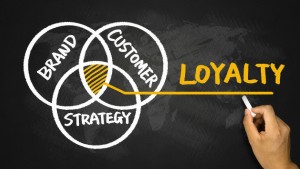How Do You Know If You've Achieved True Brand Loyalty?
A consumer is at the store, faced with a specific need and a wall full of potential solutions, looking to make a purchase decision.
This is the moment of truth for any brand – the first barrier to purchase has been crossed – the consumer is in the door and is considering that brand as an option. But success has not yet been achieved, as there are a number of factors and situations which play into a purchase decision, all of which are running through their mind as they work through the decision.
But just then, another consumer walks down the aisle toward our subject, heading straight toward the same wall of products. The difference in this instance, however, is that the second consumer heads straight toward a particular brand, without hesitation or pause.
Curious at how such a quick decision could be made, the first consumer asks the second what made it seem so easy?
“I knew exactly which brand I would get on my way here,” the second one says. “To be honest, I couldn’t even tell you what other brands make this product. It’s Brand X for me, every time.”
There it is – the goal of any brand in a competitive marketplace. To have consumers who put your brand above all others without question. It takes time and effort to achieve and maintain. It’s brand loyalty.
Consumers become loyal to certain products and brands for a number of reasons.
In some instances, the loyalty is driven by prudence. If a product provides consistently superior quality or a good price, then it’s common sense that a consumer would establish brand loyalty. Who wouldn’t lean toward the brand that is bigger, better, faster or cheaper than the competition?
The problem comes when this gets mistaken for true brand loyalty. In reality, it rarely has anything to do with the brand itself.
Plus, it’s difficult to put much weight in the “loyalty” aspect of the equation when a product that is even bigger, better faster or cheaper than the original comes along and with it goes the same consumer from before.
No, true brand loyalty supersedes these traditional purchase drivers, revealing itself as a force upon the consumer to which typical purchase-driving factors do not apply. Much like the situation above, loyalty brands are first, last and everything in between when it comes to choices for their loyal consumers.
How can you really know if you’ve achieved brand loyalty? Here are three indicators:
Consumers seek out your brand time after time, regardless of if there’s a new kid on the block.
It’s the worst nightmare for any well-established, legacy-type brand: you’re comfortably sitting at the top of the heap, but then a new brand hits the market, looking to steal the eyes and purchases of your core consumer base. However, this is really only an issue for those brands who have mistaken a sense of brand loyalty for the aforementioned common sense loyalty.
But true brand loyalty? That will make a consumer look at the new kid on the block and think, “no way I’m switching – I’ve got my brand.” Be that brand.
When your brand is a part of the consumer’s life even when they aren’t purchasing.
They don’t technically work for your brand, but it’s safe to say that these people do just as much, if not more, to spread the word for your brand than even your own employees. They’re called “brand ambassadors,” and they are defined as consumers whose loyalty doesn’t end when they make a purchase.
The connection with your brand is so strong that they want others to have what they have – in other words, your brand ambassadors fancy themselves as members of an exclusive, brand-connected club, and they want to expand the membership.
When your brand can evolve and change, without fear of losing your core consumers.
Every brand must evolve throughout its lifetime to keep up with ever-changing consumer wants and needs. These evolutionary shifts can touch all aspects of a brand, whether it is a visual branding update or a verbal brand name change, even well-established and successful brands know that complacency leads to stunted growth, and eventually, being passed by the competition.
As the saying goes, “you can’t judge a book by its cover” – for a brand going through a brand evolution, the loyalty aspect speaks to this point. Brand loyal consumers know that despite any visual or verbal changes, the core aspects of what makes a brand loyalty-worthy did not change, and they know each and every interaction with the brand will serve to reinforce their loyalty.
Has your company recently experienced change or growth? Due to changes in business strategies, acquisitions, internal organizational changes or the addition of new products to a portfolio, your brand strategy may need to evolve over time. Click here to download your free copy of “Your Brand’s Guide to Corporate Change” today, and learn how to align your brand and business strategy for success!
3 Brands Poised for Success in 2015
 Every brand wants to go into a new year with momentum, knowing their brand has the strength to make it the best year possible, but some have a brand strategy that is better suited to succeed than others.
Every brand wants to go into a new year with momentum, knowing their brand has the strength to make it the best year possible, but some have a brand strategy that is better suited to succeed than others.
Here are three brands who, through their actions in 2014 and the potential they show as the new year approaches, we feel have best set themselves up to be some the best in 2015:
This brand out of El Segundo, California that makes Nabi, a line of children’s tablets, has experienced an astounding 158,957 percent three-year growth, topping out at over $195 million in revenue in 2013. It led the company to the top  spot on the Inc. 5000 list of fastest-growing private companies in the United States for the second year in a row, a feat only achieved once before, in addition to being named America’s Most Promising Company for the year by Forbes.
spot on the Inc. 5000 list of fastest-growing private companies in the United States for the second year in a row, a feat only achieved once before, in addition to being named America’s Most Promising Company for the year by Forbes.
But what has allowed for such incredible growth and what sets it up for continued success in 2015 is Fuhu’s ability to take a very niche market and expand its offerings to cover all of the potential consumer and market areas. For instance, they offer branded accessories such as sports logo decals and Nabi-brand chargers, along with a partnership to sell special-edition versions of their tablets with brands such as Disney and Nickelodeon.
Whenever a brand can break out of a single-product offering they are more likely to sustain long-term success. When those additional products all tie in to the original and contribute to strengthening the overall brand strategy, well that’s just an added bonus that Fuhu has earned.
Franchises are the next wave of brand growth, with brands seeing this avenue as the best way to expand their reach. And no company has embraced franchising better than Anytime Fitness, which earned the top spot on Entrepreneur Magazine’s Franchise 500 list in 2014.
![]() Not only do their locations have sound business footing, they have capitalized on the nation’s thirst for healthy options and promoting a healthy lifestyle. Additionally, their concept of 24/7/365 availability works into the daily life of the person who wants to stay healthy, but needs the flexibility to do it on their own schedule.
Not only do their locations have sound business footing, they have capitalized on the nation’s thirst for healthy options and promoting a healthy lifestyle. Additionally, their concept of 24/7/365 availability works into the daily life of the person who wants to stay healthy, but needs the flexibility to do it on their own schedule.
They have over 2,500 locations and sport over 1.9 million members, with goals to open 1,500-plus units in the next five years. This growth, along with the strong brand loyalty shown by its members (more than 1,400 have tattooed the company’s logo on themselves to represent a personal accomplishment), point to another outstanding year for the folks at Anytime Fitness.
Amazon is proof that the most successful companies never stop evolving. Already the largest internet-based company in the United States with over $74 billion in revenue for 2013, but they are not willing to sit back and let the brand coast in the coming years.
 They too know the benefit of branching out with your brand, with original products, hotel booking site, streaming video services, food delivery services, and more all on deck for potential 2015 launches. They have also entered into the media creation realm, with at least seven new shows set to debut in 2015, go along with the already-successful Kindle, Amazon Prime and recent acquisition of Zappos.
They too know the benefit of branching out with your brand, with original products, hotel booking site, streaming video services, food delivery services, and more all on deck for potential 2015 launches. They have also entered into the media creation realm, with at least seven new shows set to debut in 2015, go along with the already-successful Kindle, Amazon Prime and recent acquisition of Zappos.
This touches on another branding best practice – Amazon can look to expand its product offering because it is the best at what it was originally created to do. People around the world know Amazon’s brand for its outstanding success in the past, and therefore the brand equity is there already to test the waters, knowing that anything with the Amazon name on it has a built-in brand ambassador network.
Sources:
- https://www.fool.com/premium/supernova2015/disruptor.aspx
- https://www.forbes.com/most-promising-companies/list/
- https://www.inc.com/profile/fuhu
- https://www.inc.com/magazine/201409/lindsay-blakely/inc.500-2014-number-one-fastest-growing-company-fuhu-growth-secrets.html?cid=readmore
- https://www.entrepreneur.com/article/230291
- https://www.nydailynews.com/entertainment/tv/amazon-reveals-2015-pilot-season-lineup-article-1.2006787
Is Your Brand Prepared to Capitalize on Recent Growth?
Is Your Brand Prepared to Capitalize on Recent Growth?
By Matthew Harris
Congratulations! For your company, 2014 was a banner year. From revenue and profits to number of employees and offerings, growth was the theme. The company is set up for continued success in 2015 and beyond… if you can continue making the right choices, specifically when it comes to your brand.
For companies that are coming off of a year in which they experienced their first true taste of success, the following year’s brand strategy actions and decisions can go a long way to determining how far the company can capitalize and continue to grow. One factor in this is understanding the power of your brand.
This growth has almost certainly increased your brand awareness and impacted your brand positioning. A company on the rise is likely to pique a heightened interest among its target audience compared to a company that has seen a growth plateau. Now, the challenge is to continue to increase your brand awareness and evolve your brand positioning with the goal of building a brand while not forgetting what got it to this point.
 Long-lasting, successful brands are built on a foundation of meaningful brand strategy, one that provides a strong framework for what the brand is and what it represents. A successful brand strategy serves as a roadmap for where a brand should go in the future, and how to take it there, without wasting time or money going down the wrong path.
Long-lasting, successful brands are built on a foundation of meaningful brand strategy, one that provides a strong framework for what the brand is and what it represents. A successful brand strategy serves as a roadmap for where a brand should go in the future, and how to take it there, without wasting time or money going down the wrong path.
Additionally, strong brands know the benefit of not only focusing on externally-facing touch points, but also putting in the time and resources necessary to build brand awareness and strengthen the brand with internal audiences. For an employee of a growing company, the feeling of ownership and pride for the brand is a valuable asset to have for motivation and self-satisfaction in their role within the company.
Because your company has experienced success, there is a good chance that your brand is in a strong place and has some of the tools in place that can continue its success, so a complete brand strategy overhaul is likely unnecessary. However, the market is constantly evolving, and the risk of complacency for a growing company can quickly halt any momentum gained in the past. A company’s brand positioning needs to evolve as it does, following the growth from where the brand is today to where it wants to be tomorrow.
Before you begin to create your brand strategy, you should take stock of where you are. You will have many questions regarding your business on a number of important topics, including whether you are communicating the right thing to your target audiences, what brands in your portfolio hold the most potential for continued growth, and whether a rebrand would be a successful step to take. When faced with organizing and recognizing where you are as a brand, it is a good idea to bring in a third party to handle the research and analysis, who can provide objective results that cannot be reached when the work is done internally.
There are a few areas where many growing companies can find benefit in setting a strategy of evolution, including product and service lines, social media strategies, and how you position your company to your consumers. The main focus should be on ensuring that your brand can adapt and excel in an ever-changing business environment, without compromising your core characteristics.
Set yourself up for future growth – plan and strategize with the mindset that your past success was just the beginning and soon, your brand equity will carry enough weight to begin driving a portion of your business.
Follow us on Twitter @AddisonWhitney or join the conversation on Facebook and Google+
The Rebranding of the Y

......................................................................................................................................................................
Any given day, you’re sure to find an Addison Whitney employee at the Y running on a tredmill or perfecting Zumba moves. As a member of the YMCA of Greater Charlotte, I received an email last week from the President & CEO and Metropolitan Board Chair that blew my mind – in a good way.
By the time I’d received the email, I’d heard the news of the YMCA’s rebranding to the Y. I had seen the new logo and color palette. And I had read quite a few articles and blog entries cheering and jeering the change.
But this email was different because it was from my Y. The email, entitled “Still Your YMCA,” communicated the changes members can expect including a new brand strategy defining its cause of strengthening the foundations of community and a refreshed logo. But it also told members what would not change: the mission, core values and services members enjoy.
A key to successfully introducing a rebranding effort to your target audience is communication. As a member of the brand strategy team, we tell our clients going through rebranding efforts to do just what the Y did so well. Tell your target audience why you did it, how you did it and what they can expect. Change can be scary, so calm any fears by clearly stating what will not change.
The email from the YMCA of Greater Charlotte says it best: “As you can see, the Y isn't changing any of the great programs and services that we've always provided; we're just trying to do a better job of explaining why they matter.”
And you’re off to a great start.
Best Brand Strategy

......................................................................................................................................................................
A great brand strategy is akin to a broken record: Say one thing over and over. This consistency of message across brand touch points is what sets a brand apart from its competition and captures mindshare. Delivering on that message establishes ownership of a category and drives brand loyalty.
One brand has been unwavering in staking its claim on the idea of high-performance in the automotive world. With a history in airplane engines and motorcylces, this brand introduced the Read more
